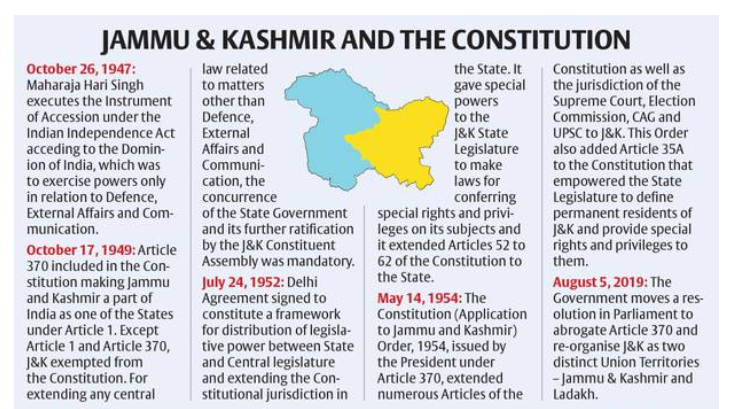Jammu and Kashmir Status

Copyright infringement is not intended
Context: The Union Government Stated that there has been normalcy in Jammu and Kashmir since the government of India revoked Article 370.
Details:
- The Finance Minister of India stated that there has been normalcy in Jammu and Kashmir since the Union Government revoked the special constitutional status of the erstwhile state of Jammu and Kashmir under Article 370.
- After the removal of Art 370, nearly 900 central laws have now become applicable to Jammu and Kashmir.
- “Highest ever tourist footfall of 50,33,956 from October 2021 to January 2022.
- 40,000 projects were completed in 2021-22.
- All indicators of terrorism were falling. “There has been a 33% drop in police personnel being martyred. There has been a 90% decrease in ceasefire violations.
Status of Jammu and Kashmir
- Jammu and Kashmir lies to the north of the Indian states of Himachal Pradesh and Punjab and to the west of Ladakh, which is also subject to the dispute as a part of Kashmir, and administered by India as a union territory.
- Some areas have been disputed between India and Pakistan since 1947 and between India and China since 1962.
- The Line of Control separates Jammu and Kashmir from the Pakistani-administered territories of Azad Kashmir and Gilgit-Baltistan in the west and north.
- The state of Jammu and Kashmir was accorded special status by Article 370 of the Constitution of India.
- Jammu and Kashmir had its own constitution, flag and administrative autonomy.
- Indian citizens from other states were not allowed to purchase land or property in Jammu and Kashmir.
- Unrest and violence persisted in the Kashmiri Valley and, following a disputed state election in 1987, an insurgency persisted in protest over autonomy and rights.
- A resolution to repeal Article 370 was passed by both the houses of the Parliament of India in August 2019. At the same time, a reorganization act was also passed, which reconstituted the state into two union territories, Jammu and Kashmir and Ladakh. The reorganization took effect from 31 October 2019.
- This also suspended Article 35A.
- Article 35A had allowed J&K to define who its ‘permanent residents’ are and what rights and privileges are attached to such residency.
- At present, the union territory of Jammu and Kashmir is administered under the provisions of Article 239 of the Constitution of India. The Article 239A, originally formulated for the union territory of Puducherry, will also be applicable to Jammu and Kashmir.
- The union territory is under the jurisdiction of the Jammu and Kashmir High Court, which also serves as high court for Ladakh.
- In Parliament: Jammu and Kashmir now has 5 Lok Sabha Seats and 4 Rajya Sabha Seats.
Key facts about Jammu and Kashmir:
- Jammu and Kashmir is home to several valleys such as the Kashmir Valley, Tawi Valley, Chenab Valley, Poonch Valley, Sind Valley and Lidder Valley.
- The Himalayas divide the Kashmir valley from the Tibetan plateau while the Pir Panjal range, which encloses the valley from the west and the south, separates it from the Punjab Plain of the Indo-Gangetic Plain.
- The Jhelum River is the major Himalayan River which flows through the Kashmir valley. The Tawi, Ravi and Chenab are the other important rivers flowing through the region.
- The union territory of Jammu and Kashmir is divided into 20 districts and consists of two divisions: Jammu Division and Kashmir Division.
- Important Tribes; Gujjar, Bakerwal, and Gaddi.
- The most widely spoken language in Jammu and Kashmir is Kashmiri, the mother tongue of 52.72% of the population according to the 2011 census. The second most spoken language is Dogri, spoken by 20% of the population.
- According to the 2011 census, literacy rate in Jammu and Kashmir was 67.17%.



1.png)
